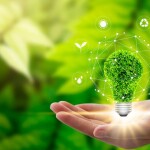Introduction
Sustainable technology refers to the development and utilization of technological solutions that minimize environmental impact and promote long-term ecological balance. It encompasses a wide range of innovations that address various aspects of sustainability, including renewable energy, energy efficiency, waste management, sustainable agriculture, water conservation, green building practices, and sustainable transportation.
The Need for Sustainable Technology
The pressing need for sustainable technology arises from the detrimental effects of traditional technologies on the environment. Fossil fuel-based energy sources, inefficient manufacturing processes, and unsustainable consumption patterns have contributed to climate change, resource depletion, and pollution. To combat these challenges, sustainable technology offers promising solutions that reduce greenhouse gas emissions, conserve resources, and promote a circular economy.
Renewable Energy Solutions
Solar Power
Solar power harnesses energy from the sun and converts it into electricity through photovoltaic panels or solar thermal systems. This renewable energy source is abundant, clean, and readily available. The use of solar power reduces dependence on fossil fuels, decreases carbon emissions, and promotes energy independence.
Wind Energy
Wind energy utilizes wind turbines to generate electricity. As wind is a free and abundant resource, harnessing it for power generation is a sustainable alternative to conventional energy sources. Wind farms are being established worldwide to tap into this clean and renewable energy, contributing to a greener future.
Hydroelectric Power
Hydroelectric power generates electricity by utilizing the force of flowing or falling water. Large-scale hydroelectric plants and small-scale micro-hydro systems are used to harness this renewable energy source. Hydroelectric power is a reliable and environmentally friendly option, as it produces clean electricity without emitting greenhouse gases.
Energy Efficiency Technologies
Smart Grids
Smart grids integrate advanced communication and control technologies into traditional electrical grids, enabling efficient distribution and consumption of electricity. They optimize energy flow, reduce transmission losses, and accommodate the integration of renewable energy sources. Smart grids contribute to energy conservation and promote the stability of the electrical grid.
Energy-Efficient Buildings
Energy-efficient buildings are designed to minimize energy consumption and maximize comfort. They incorporate features such as insulation, efficient lighting, smart thermostats, and energy management systems. These buildings reduce energy demand, lower carbon emissions, and provide a healthier indoor environment.
Electric Vehicles
Electric vehicles (EVs) are powered by electricity stored in rechargeable batteries. They offer a sustainable alternative to conventional vehicles that run on fossil fuels. EVs reduce greenhouse gas emissions, decrease air pollution, and contribute to a cleaner transportation sector.
Waste Management Innovations
Recycling and Upcycling
Recycling and upcycling are sustainable waste management practices that aim to reduce the amount of waste sent to landfills. Recycling involves converting waste materials into new products, while upcycling repurposes discarded items for new uses. These practices conserve resources, minimize pollution, and promote a circular economy.
Waste-to-Energy Conversion
Waste-to-energy conversion technologies convert organic waste into useful forms of energy, such as heat, electricity, or fuel. Anaerobic digestion, incineration, and gasification are some of the methods employed in this process. Waste-to-energy conversion helps reduce landfill waste, recover valuable resources, and generate renewable energy.
Circular Economy Models
Circular economy models focus on minimizing waste generation and maximizing resource efficiency. They emphasize the reuse, repair, and recycling of products and materials. By adopting circular economy practices, we can reduce the consumption of finite resources and create a more sustainable and resilient economy.
Sustainable Agriculture and Food Systems
Vertical Farming
Vertical farming involves the cultivation of crops in vertically stacked layers, using artificial lighting and controlled environments. This innovative farming technique maximizes crop yield per unit area, conserves water, and reduces the need for pesticides and fertilizers. Vertical farming has the potential to revolutionize food production and address the challenges of urbanization and limited arable land.
Precision Agriculture
Precision agriculture utilizes technology, such as GPS, sensors, and drones, to optimize agricultural practices. It enables farmers to monitor crop health, optimize water and fertilizer usage, and minimize waste. Precision agriculture promotes sustainable farming practices, increases productivity, and reduces environmental impact.
Plant-Based Alternatives
Plant-based alternatives to animal products, such as plant-based meat and dairy substitutes, offer a sustainable solution to reduce the environmental footprint of the food industry. These alternatives require fewer resources, emit fewer greenhouse gases, and help mitigate climate change while providing consumers with sustainable and healthy options.
Water Conservation Technologies
Water Purification Systems
Water purification systems employ various technologies, including filtration, disinfection, and desalination, to treat and purify water for various purposes. These systems help ensure access to clean drinking water, reduce waterborne diseases, and promote water conservation.
Drip Irrigation
Drip irrigation is an efficient irrigation method that delivers water directly to plant roots, minimizing water wastage. By providing precise and controlled irrigation, drip irrigation optimizes water usage, conserves water resources, and increases crop yield.
Rainwater Harvesting
Rainwater harvesting involves collecting and storing rainwater for later use. It can be implemented at the individual or community level, providing an additional water source and reducing dependence on freshwater supplies. Rainwater harvesting is a sustainable practice that conserves water and helps mitigate water scarcity.
Green Building Practices
Green Materials
Green buildings utilize sustainable and eco-friendly materials during construction. These materials are sourced responsibly, minimize environmental impact, and enhance indoor air quality. Green buildings are energy-efficient, promote occupant well-being, and contribute to a sustainable built environment.
Passive Design Strategies
Passive design strategies optimize building design and orientation to maximize natural lighting, ventilation, and thermal comfort. By reducing the need for artificial lighting, heating, and cooling, passive design strategies decrease energy consumption and enhance energy efficiency.
Net-Zero Energy Buildings
Net-zero energy buildings produce as much energy as they consume over a given period. They incorporate energy-efficient features, renewable energy systems, and energy storage solutions to achieve a neutral energy balance. Net-zero energy buildings play a vital role in reducing greenhouse gas emissions and combating climate change.
Sustainable Transportation Solutions
Mass Transit Systems
Mass transit systems, such as buses, trains, and trams, offer sustainable alternatives to individual car travel. They reduce traffic congestion, air pollution, and carbon emissions. By promoting public transportation, cities can improve mobility, enhance air quality, and create more sustainable urban environments.
Bike-Sharing Programs
Bike-sharing programs provide access to bicycles for short-distance trips within cities. They encourage active transportation, reduce reliance on motor vehicles, and promote physical activity and health. Bike-sharing programs contribute to a greener and more sustainable transportation network.
Carpooling and Ride-Sharing Apps
Carpooling and ride-sharing apps facilitate the sharing of private vehicles among commuters traveling in the same direction. These services reduce the number of cars on the road, decrease traffic congestion, and lower carbon emissions. Carpooling and ride-sharing contribute to sustainable transportation solutions and promote resource efficiency.
The Role of Artificial Intelligence
Artificial intelligence (AI) is increasingly being applied to optimize resource management, energy efficiency, and transportation systems. AI-based algorithms and predictive analytics enable intelligent decision-making, energy optimization, and traffic management. By leveraging AI, sustainable technology can achieve higher levels of efficiency, productivity, and sustainability.
Sustainable Technology in Developing Countries
Sustainable technology plays a crucial role in addressing the unique challenges faced by developing countries. Off-grid energy solutions, portable water purification devices, and low-cost green construction techniques are examples of sustainable technologies that can improve living conditions, provide access to basic services, and promote sustainable development.
Challenges and Future Prospects
Despite the progress made in sustainable technology, there are still challenges to overcome. These include high costs, technological barriers, limited awareness, and policy gaps. However, with continued research, innovation, and collaboration, the future of sustainable technology looks promising. Advancements in technology, coupled with supportive policies and widespread adoption, can lead us toward a greener and more sustainable future.
Conclusion
Sustainable technology offers innovative solutions to tackle environmental challenges and create a greener future. From renewable energy and energy efficiency technologies to waste management innovations and sustainable agriculture practices, these advancements contribute to resource conservation, pollution reduction, and climate change mitigation. By embracing sustainable technology, we can transition to a more sustainable and resilient society.
Frequently Asked Questions (FAQs)
1. How is sustainable technology beneficial for the environment?
Sustainable technology minimizes environmental impact by reducing resource consumption, greenhouse gas emissions, and pollution. It promotes the conservation of natural resources and helps mitigate the adverse effects of climate change.
2. What are the key features of green buildings?
Green buildings incorporate energy-efficient designs, sustainable materials, and advanced technologies to optimize resource usage. They prioritize energy conservation, water efficiency, indoor environmental quality, and waste reduction.
3. How can renewable energy technologies help in reducing carbon emissions?
Renewable energy technologies, such as solar power and wind energy, produce electricity without emitting greenhouse gases. By replacing fossil fuel-based energy sources, renewable energy technologies contribute to the reduction of carbon emissions and combat climate change.
4. Are there any government incentives for adopting sustainable technologies?
Many governments offer incentives, such as tax credits, grants, and subsidies, to encourage the adoption of sustainable technologies. These incentives aim to promote sustainable practices, accelerate innovation, and support the transition to a greener economy.
5. What role does consumer behavior play in promoting sustainable technology?
Consumer behavior plays a crucial role in driving the adoption of sustainable technology. By choosing eco-friendly products, supporting sustainable businesses, and adopting sustainable practices, consumers can create a demand for sustainable technologies and contribute to a greener future.








